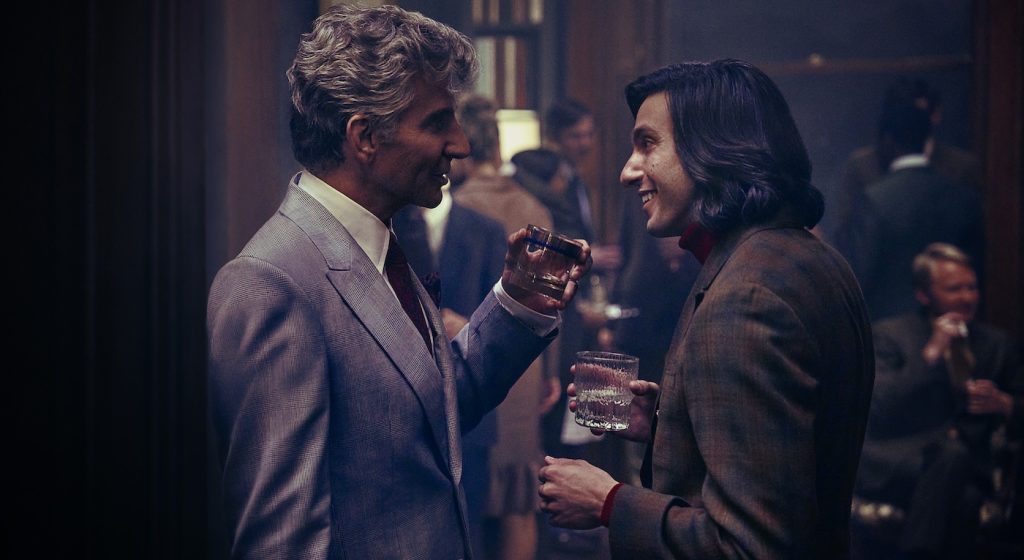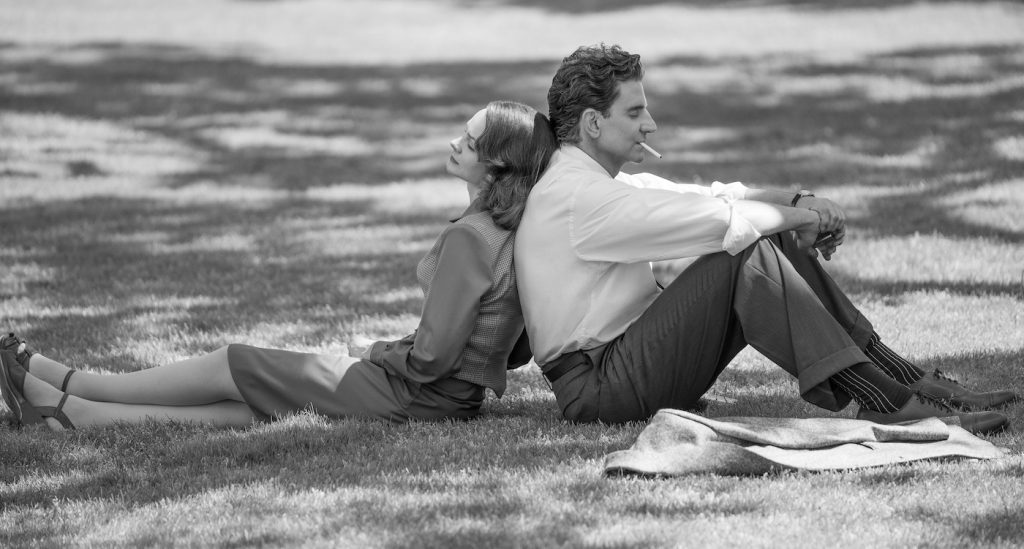“Maestro” Oscar-Nominated Re-Recording Mixers on Building Emotion With & Without Music
In Bradley Cooper’s Maestro, the music is flipped. Tracking the arc of Leonard Bernstein’s career in tandem with his loving but complicated marriage to Chilean actress Felicia Monteleagre (Carey Mulligan), the film’s music is Bernstein’s music, playing as it did over the course of the composer’s life, whether that’s performed on stage or worked out in the studio at the family’s Fairfield country house. When we revisit emotionally charged, private moments from Bernstein’s life, at a frightfully strained family Thanksgiving, or when he finally lies to his oldest daughter about his affairs, there is no underscore conveying to the audience what to feel. Instead, the dialogue’s weight is underpinned by a seemingly simple but deliberate atmosphere.
Re-recording mixers Tom Ozanich and Dean Zupancic worked to create subliminal rhythms in scenes like these so that even something as ordinary as the wind or a bird coming or going supports where Bernstein is emotionally, whether that’s falling in love with Felicia or concealing huge parts of his life from his children. Their work has led to Oscar nominations, alongside their sound colleagues Steven A. Morrow [sound mixer], Richard King [supervising sound editor], and Jason Ruder [supervising music producer].
We had the chance to speak with Zupancic and Ozanich about the sound department’s supercharged focus on rhythm throughout the Maestro edit, how they balanced key musical moments with an unusual approach to dialogue, and took on the film’s period elements to make them feel true but never gimmicky.
Some of Maestro’s most emotionally charged moments take place at parties, particularly at Lenny and Felicia’s home in the Dakota. How did you manage the unusual approach to sound during those scenes?
Tom Ozanich: That was recorded not only by miking up the principal actors, but a bunch of extras, other actors in the scene, and plant mikes. Bradley wanted to have it feel real. For the actors, it did add this real feeling that they had to speak up over a crowd. From a technical standpoint, the tricky part is that all those people are actually talking. The big challenge is maintaining control over what the main actors are talking about at any moment. Because of the proximity to microphones, you sometimes get problems when people standing near Bradley pick him up on their microphone, making their microphone somewhat unusable. It has to be downplayed, or it’s going to cause a bad-sounding version of his. We want him to sound rich and full and close. It’s a constant evaluation of what to use.
Dean Zupancic: And a bit of a dialogue editor nightmare.
Ozanich: Tony Martinez was our dialogue supervisor, and he did a great job of trying to give me all the parts that were actually usable.

What did your work entail during big performance scenes, like at Carnegie Hall, where the music is as important as the dialogue?
Ozanich: When we first meet Lenny, and he wakes up and runs into Carnegie Hall, it’s a great example of how we were trying to really make the whole movie musical, even the stuff that’s not necessarily music. In that case, the music is a very featured forefront part of the soundtrack, and then the conversation comes in, and you can follow it, but the music is not trying to back away and give us space for that. We really wanted the music to be this critical center of the film. It doesn’t play like it normally would. There’s a radio broadcast at the end, and you miss a bit of it, and that’s intentional. You hear the key parts.
Zupancic: And when he walks onto the stage, and no one in the audience makes a sound, all you can hear are his footsteps. There are so many subliminal rhythms. In mixing, the mantra of this movie was that it had to be rhythmic to highlight Bernstein’s music. The effects of the crowd mimic the movement of the camera. As the camera turns, the crowds sweep around and by us. There are a lot of little incidentals to make it all feel real.
What’s another example of subliminal rhythm that we hear but a layperson might not notice?
Zupancic: All the scenes have some kind of rhythm. There’s a rhythm to how the winds come in and go away. There’s a rhythm to how the birds are tweeting, whether it’s a dove or a crow. It’s nothing that the audience probably picks up on, but it’s a feeling you get. It’s sprinkled throughout the entire film. It was always the thought to be rhythmic, and that was the first thing we discussed when planning with Richard King to build the effects. And in a lot of transitions, the A-side is going across the cut while the B-side is coming in, so there’s always a fluid rhythm to the cut. There aren’t a lot of hard cuts in the movie.
Ozanich: Which really emphasizes the couple cuts that are deliberately extreme. At the end of Carnegie, there’s this huge applause, and it hard cuts to the dressing room. The same thing happens at the end of the Ely scene. There’s this giant applause, and boom; it hard cuts into the tragedy that then unfolds. One of our main driving motives was to always serve that emotional storyline, so everything is designed to support that.
And when we’re out in the country with the Bernstein family, there’s a sense of timelessness, and it’s often very quiet. How did you maintain the emotion in those scenes?
Zupancic: Especially in what we call the big lie, when Lenny’s on the porch talking to Jamie, there are quite a few dramatic dialogue scenes that were not scored, so it was up to the backgrounds to deliver the emotion. Those scenes are tough to mix because you have to sound real, obviously, but we still have to support the emotion of what’s going on. I thought playing a lot of those scenes without music was a brilliant decision by Bradley and Jason Ruder, our supervising music editor, because then, when the music does come in, it’s so much more impactful.
Ozanich: I think one of the great, powerful things about sound is that people don’t think as overtly about what they’re hearing as they do about what they’re seeing, yet all of that is having an effect on your experience and what you’re feeling. Normally, you’d use music to be this underscore, to tell you what to feel, and a lot of the more intimate scenes don’t have it. It’s totally leaning on the actual performances as well as some of the sound.
Zupancic: The other great scene I love, too, is when Lenny’s having the interview outside the pool. The winds are blowing, you feel it, the birds are in the background, but it’s all weaving through what the story is telling us.
Ozanich: That scene has a lot of heaviness to it, in the backgrounds where you feel this weight and a darkness. In that whole scene, Lenny is struggling with what he’s being confronted with in that interview. You contrast that to some of the scenes early on with Felicia, when they’re sitting back to back, and it’s beautiful, it’s light, there are beautiful birds, and you feel like you’re falling in love like them.


in Maestro. Cr. Jason McDonald/Netflix © 2023.
Going into the edit, were there any rules or guidelines to deal with the fact that this is a period piece?
Ozanich: Yes and no. We talked about attempting to do some more dramatic, period-based transitions. Ultimately, we decided not to put the limitations of those time periods there because it felt like that was going to break how real it feels and how tangible they are, sitting there in front of us. What we did decide to do was use today’s technology but make it have a feeling and a flavor of those time periods. So, for some of the older stuff, you wouldn’t have as dense of a track; maybe there’s less background without every detail playing.
Zupancic: We didn’t want to rely on technical gimmicks, i.e., making it sound like a 1940s film, but rather, again, the movie is rhythm and feeling, so make it feel like a 1940s movie, then as you get into color, the feeling of the 1970s, which is a time when more sounds were being played, more detail.
Ozanich: It’s amazing to me because I feel like we didn’t overly focus on that. We did have some intentionality to it, but I just felt like what we’re doing is so subtle, no one is even going to notice it, and yet we’ve had so many people asking, how did we make it sound like that time period?
For more on Maestro, check out these interviews:
“Maestro” Costume Designer Mark Bridges on Charting the Bernstein’s Ever-Changing Style
“Maestro” Cinematographer Matthew Libatique Makes Music With the Camera
Featured image: Maestro – BTS – (L to R) Bradley Cooper as Leonard Bernstein (Director/Writer/Producer), Cinematographer Matthew Libatique and Carey Mulligan as Felicia Montealegre on the set of Maestro. Cr. Jason McDonald/Netflix © 2023.



